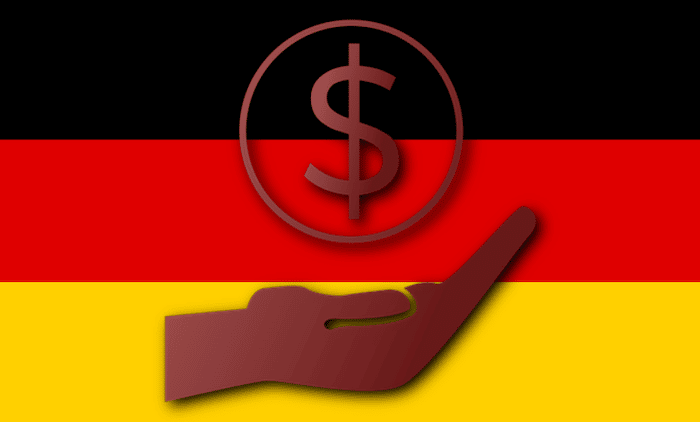Fossil raw materials: Gas trader VNG is slowly turning green
[ad_1]
A pressure gauge shows the pressure in the natural gas network on the site of a VNG gas storage facility.
Photo: dpa/Sören Stache
The deep worry lines have disappeared. When the Leipzig gas trader VNG presented its balance sheet a year ago, it seemed uncertain how many more such events there would be. Because of the loss of natural gas deliveries from Russia and the extremely expensive procurement of replacements from other sources, the group, which is the largest company based in East Germany with at least 1,700 employees, consumed its equity at a breathtaking pace; At times there was even talk of nationalization. Twelve months later, a completely different and much more optimistic conclusion is drawn. In 2023, an “extraordinary result” was achieved that “far exceeds our expectations,” said CEO Ulf Heitmüller, but of course he immediately curbed the euphoria a little: “This profit situation will not be repeated” in 2024.
Specifically, VNG, which earns its money primarily from trading, transporting, distributing and storing natural gas and emerged from the Technical Management Ferngas, which was founded in 1958 and was then based in Dessau, made a profit of 380 million euros last year. In 2023, the bottom line was a loss of 337 million euros. At 23.2 billion euros, sales were around a third below the 36.2 billion in the previous year. The reason was the development of gas prices, said CFO Bodo Rodestock. In 2022, these had exploded to ten times the usual level, which was reflected in excessively inflated sales.
nd.DieWoche – our weekly newsletter

With our weekly newsletter nd.TheWeek look at the most important topics of the week and read them Highlights our Saturday edition on Friday. Get your free subscription here.
Of course, this was offset by enormous additional expenses for purchasing the gas, which brought the company to the brink of ruin. A year ago, three euros had to be paid for one kilowatt hour of natural gas, but currently only three cents are due on trading exchanges. However, the level is still higher than before the Ukraine war, when there were even “negative natural gas prices” at times, as Heitmüller recalled. The VNG CEO expects prices to “stay the same to some extent in the future.” However, fluctuations are more likely than in the past.
The company previously purchased its natural gas based on stable long-term contracts almost exclusively from Russia. The first natural gas was purchased from there in 1973. The relationship survived the end of the GDR and the Soviet Union. Until 2015, Russia’s Gazprom even held a direct stake of 10.52 percent in VNG; Until then, annual press conferences were simultaneously translated into Russian.
The attack on Ukraine hit these relationships to the core. The connections have now been “completely severed,” as Heitmüller says. VNG now sources its gas through direct contracts from Norway and, to a smaller extent, from Algeria; It is also purchased on international markets. LNG, i.e. liquefied natural gas, is also purchased there, 85 percent of which comes from the USA and the prices for which are subject to greater fluctuations. Heitmüller says they are “now more closely involved in global price setting.”
Trading and storage of natural gas will remain the most important field of activity for VNG in the near and medium future. “One thing is clear: we need natural gas for a longer period of time in order to be able to secure Germany’s supply,” says Heitmüller. The final phase-out is not planned until 2045, even if the share in the energy mix will gradually decrease.
The fossil and therefore climate-damaging energy source will gradually be replaced by “green” fuels, especially hydrogen and biogas. VNG is preparing for this time. A subsidiary already operates 40 biogas plants with a capacity of 178 megawatts. These could supply 120,000 households annually, said VNG Chief Technology Officer Hans-Joachim Polk. He admitted that the share of green gases in group sales has so far been “negligible”. CFO Rodestock put it at 100 million euros. However, he noted that 200 million euros had already been invested in the area. “This is something for the future,” said Polk, emphasizing that in the future they want to trade with hydrogen to the same extent as is now the case with natural gas.
The fuel of the future will come from different sources. VNG wants to produce some of it itself. A pilot plant is being built for this purpose in Bad Lauchstädt. The company announced that it wanted to build an electrolyzer with a capacity of 30 megawatts in which green hydrogen would be produced using electricity from eight wind turbines. However, he could Hydrogen demand in Germany, which VNG puts at 90 to 130 terawatt hours in 2030, cannot be covered exclusively domestically – and not only from green hydrogen. It is “important to also take decarbonized hydrogen into account,” said Polk. VNG wants to produce this in Rostock, for example, from Norwegian natural gas. The captured carbon dioxide is to be pressed into its own offshore storage facilities off the Norwegian coast.
In this context, Heitmüller welcomed the fact that the federal government has recently focused “intensively” on the issue of CO2-Separation. At the end of February, Federal Minister of Economics Robert Habeck announced that they wanted to examine the conditions for being able to capture and store climate-damaging carbon dioxide in the future. Environmental groups have vehemently criticized the plans.
Subscribe to the “nd”

Being left is complicated.
We keep track!
With our digital promotional subscription you can read all issues of »nd« digitally (nd.App or nd.Epaper) for little money at home or on the go.
Subscribe now!
[ad_2]
Source link



